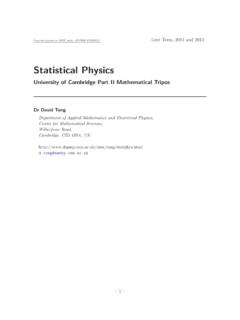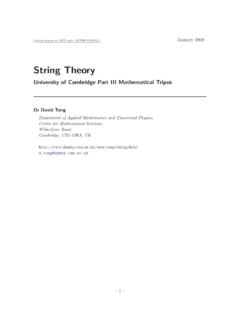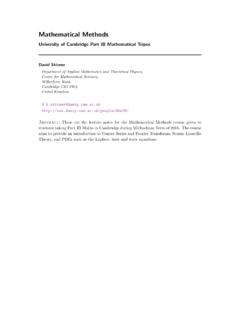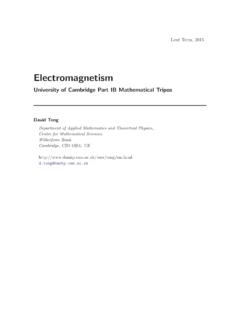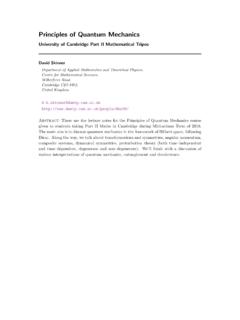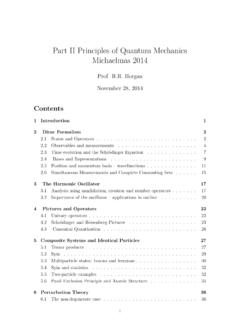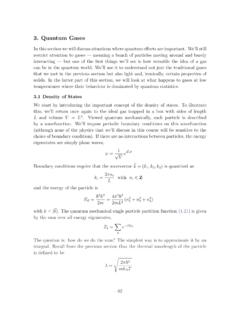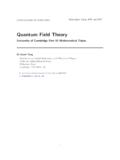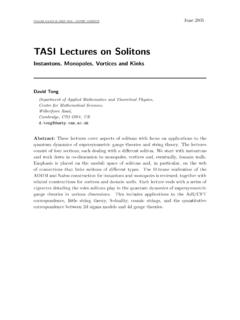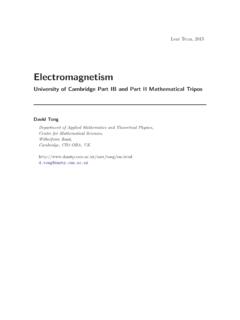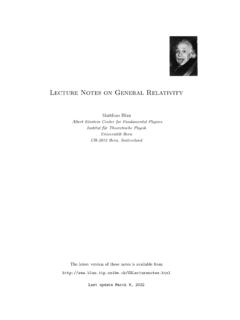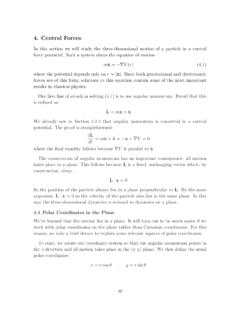Transcription of Dynamics and Relativity - University of Cambridge
1 Preprint typeset in JHEP style - HYPER VERSION Lent Term, 2013. Dynamics and Relativity University of Cambridge Part IA Mathematical Tripos David Tong Department of Applied Mathematics and Theoretical Physics, Centre for Mathematical Sciences, Wilberforce Road, Cambridge , CB3 OBA, UK. 1 . Recommended Books and Resources Tom Kibble and Frank Berkshire, Classical Mechanics . Douglas Gregory, Classical Mechanics . Both of these books are well written and do an excellent job of explaining the funda- mentals of classical mechanics. If you're struggling to understand some of the basic concepts, these are both good places to turn. S. Chandrasekhar, Newton's Principia (for the common reader) . Want to hear about Newtonian mechanics straight from the horse's mouth? This is an annotated version of the Principia with commentary by the Nobel prize winning astrophysicist Chandrasekhar who walks you through Newton's geometrical proofs. Although, in fairness, Newton is sometimes easier to understand than Chandra.
2 French, Special Relativity . A clear introduction, covering the theory in some detail. Wolfgang Pauli, Theory of Relativity . Pauli was one of the founders of quantum mechanics and one of the great physicists of the last century. Much of this book was written when he was just 21. It remains one of the most authoritative and scholarly accounts of special Relativity . It's not for the faint of heart. (But it is cheap). A number of excellent lecture notes are available on the web. Links can be found on the course webpage: Contents 1. Newtonian Mechanics 1. Newton's Laws of Motion 2. Newton's Laws 3. Inertial Frames and Newton's First Law 4. Galilean Relativity 5. Newton's Second Law 8. Looking Forwards: The Validity of Newtonian Mechanics 9. 2. Forces 11. Potentials in One Dimension 11. Moving in a Potential 13. Equilibrium: Why (Almost) Everything is a Harmonic Oscillator 16. Potentials in Three Dimensions 18. Central Forces 20. Angular Momentum 21.
3 Gravity 22. The Gravitational Field 22. Escape Velocity 24. Inertial vs Gravitational Mass 25. Electromagnetism 26. The Electric Field of a Point Charge 27. Circles in a Constant Magnetic Field 28. An Aside: Maxwell's Equations 31. Friction 31. Dry Friction 31. Fluid Drag 32. An Example: The Damped Harmonic Oscillator 33. Terminal Velocity with Quadratic Friction 34. 3. Interlude: Dimensional Analysis 40. 1 . 4. Central Forces 48. Polar Coordinates in the Plane 48. Back to Central Forces 50. The Effective Potential: Getting a Feel for Orbits 52. The Stability of Circular Orbits 53. The Orbit Equation 55. The Kepler Problem 56. Kepler's Laws of Planetary Motion 60. Orbital Precession 62. Scattering: Throwing Stuff at Other Stuff 63. Rutherford Scattering 65. 5. Systems of Particles 67. Centre of Mass Motion 67. Conservation of Momentum 68. Angular Momentum 68. Energy 69. In Praise of Conservation Laws 70. Why the Two Body Problem is Really a One Body Problem 71.
4 Collisions 72. Bouncing Balls 73. More Bouncing Balls and the Digits of 74. Variable Mass Problems 76. Rockets: Things Fall Apart 77. Avalanches: Stuff Gathering Other Stuff 80. Rigid Bodies 81. Angular Velocity 82. The Moment of Inertia 82. Parallel Axis Theorem 85. The Inertia Tensor 87. Motion of Rigid Bodies 88. 6. Non-Inertial Frames 93. Rotating Frames 93. Velocity and Acceleration in a Rotating Frame 94. Newton's Equation of Motion in a Rotating Frame 95. Centrifugal Force 97. An Example: Apparent Gravity 97. 2 . Coriolis Force 99. Particles, Baths and Hurricanes 100. Balls and Towers 102. Foucault's Pendulum 103. Larmor Precession 105. 7. Special Relativity 107. Lorentz Transformations 108. Lorentz Transformations in Three Spatial Dimensions 111. Spacetime Diagrams 112. A History of Light Speed 113. Relativistic Physics 115. Simultaneity 115. Causality 117. Time Dilation 118. Length Contraction 122. Addition of Velocities 124. The Geometry of Spacetime 125.
5 The Invariant Interval 125. The Lorentz Group 128. A Rant: Why c = 1 131. Relativistic Kinematics 132. Proper Time 133. 4-Velocity 134. 4-Momentum 136. Massless Particles 138. Newton's Laws of Motion 140. Acceleration 141. Indices Up, Indices Down 144. Particle Physics 145. Particle Decay 146. Particle Collisions 147. Spinors 150. The Lorentz Group and SL(2, C) 151. What the Observer Actually Observes 154. Spinors 159. 3 . Acknowledgements I inherited this course from Stephen Siklos. His excellent set of printed lecture notes form the backbone of these notes and can be found at: I'm grateful to the students, and especially Henry Mak, for pointing out typos and corrections. My thanks to Alex Considine for putting up with the lost weekends while these lectures were written. 4 . 1. Newtonian Mechanics Classical mechanics is an ambitious theory. Its purpose is to predict the future and reconstruct the past, to determine the history of every particle in the Universe.
6 In this course, we will cover the basics of classical mechanics as formulated by Galileo and Newton. Starting from a few simple axioms, Newton constructed a mathematical framework which is powerful enough to explain a broad range of phenomena, from the orbits of the planets, to the motion of the tides, to the scattering of elementary particles. Before it can be applied to any specific problem, the framework needs just a single input: a force. With this in place, it is merely a matter of turning a mathematical handle to reveal what happens next. We start this course by exploring the framework of Newtonian mechanics, under- standing the axioms and what they have to tell us about the way the Universe works. We then move on to look at a number of forces that are at play in the world. Nature is kind and the list is surprisingly short. Moreover, many of forces that arise have special properties, from which we will see new concepts emerging such as energy and conserva- tion principles.
7 Finally, for each of these forces, we turn the mathematical handle. We turn this handle many many times. In doing so, we will see how classical mechanics is able to explain large swathes of what we see around us. Despite its wild success, Newtonian mechanics is not the last word in theoretical physics. It struggles in extremes: the realm of the very small, the very heavy or the very fast. We finish these lectures with an introduction to special Relativity , the theory which replaces Newtonian mechanics when the speed of particles is comparable to the speed of light. We will see how our common sense ideas of space and time are replaced by something more intricate and more beautiful, with surprising consequences. Time goes slow for those on the move; lengths get smaller; mass is merely another form of energy. Ultimately, the framework of classical mechanics falls short of its ambitious goal to tell the story of every particle in the Universe.
8 Yet it provides the basis for all that follows. Some of the Newtonian ideas do not survive to later, more sophisticated, theories of physics. Even the seemingly primary idea of force will fall by the wayside. Instead other concepts that we will meet along the way, most notably energy, step to the fore. But all subsequent theories are built on the Newtonian foundation. Moreover, developments in the past 300 years have confirmed what is perhaps the most important legacy of Newton: the laws of Nature are written in the language of 1 . mathematics. This is one of the great insights of human civilisation. It has ushered in scientific, industrial and technological revolutions. It has given us a new way to look at the Universe. And, most crucially of all, it means that the power to predict the future lies in hands of mathematicians rather than, say, gypsy astrologers. In this course, we take the first steps towards grasping this power. Newton's Laws of Motion Classical mechanics is all about the motion of particles.
9 We start with a definition. Definition: A particle is an object of insignificant size. This means that if you want to say what a particle looks like at a given time, the only information you have to specify is its position. During this course, we will treat electrons, tennis balls, falling cats and planets as particles. In all of these cases, this means that we only care about the position of the object and our analysis will not, for example, be able to say anything about the look on the cat's face as it falls. However, it's not immediately obvious that we can meaningfully assign a single position to a complicated object such as a spinning, mewing cat. Should we describe its position as the end of its tail or the tip of its nose? We will not provide an immediate answer to this question, but we will return to it in Section 5 where we will show that any object can be treated as a point-like particle if we look at the motion of its centre of mass.
10 To describe the position of a particle we need a reference z frame. This is a choice of origin, together with a set of axes which, for now, we pick to be Cartesian. With respect to this frame, the x position of a particle is specified by a vector x, which we denote using bold font. Since the particle moves, the position depends on y time, resulting in a trajectory of the particle described by Figure 1: x = x(t). In these notes we will also use both the notation x(t) and r(t) to describe the trajectory of a particle. The velocity of a particle is defined to be dx(t). v . dt 2 . Throughout these notes, we will often denote differentiation with respect to time by a dot above the variable. So we will also write v = x . The acceleration of the particle is defined to be d2 x(t). a x =. dt2. A Comment on Vector Differentiation The derivative of a vector is defined by differentiating each of the components. So, if x = (x1 , x2 , x3 ) then . dx dx1 dx2 dx3.
